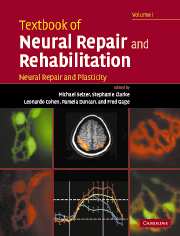Book contents
- Frontmatter
- Contents
- Contents (contents of Volume II)
- Preface
- Contributors (contributors of Volume I)
- Contributors (contributors of Volume II)
- Neural repair and rehabilitation: an introduction
- Section A Neural plasticity
- Section A1 Cellular and molecular mechanisms of neural plasticity
- Section A2 Functional plasticity in CNS system
- Section A3 Plasticity after injury to the CNS
- Section B1 Neural repair
- Section B2 Determinants of regeneration in the injured nervous system
- Section B3 Promotion of regeneration in the injured nervous system
- Section B4 Translational research: application to human neural injury
- 31 Alzheimer's disease, model systems and experimental therapeutics
- 32 Biomimetic design of neural prostheses
- 33 Brain–computer interfaces for communication and control
- 34 Status of neural repair clinical trials in brain diseases
- Index
31 - Alzheimer's disease, model systems and experimental therapeutics
from Section B4 - Translational research: application to human neural injury
Published online by Cambridge University Press: 05 March 2012
- Frontmatter
- Contents
- Contents (contents of Volume II)
- Preface
- Contributors (contributors of Volume I)
- Contributors (contributors of Volume II)
- Neural repair and rehabilitation: an introduction
- Section A Neural plasticity
- Section A1 Cellular and molecular mechanisms of neural plasticity
- Section A2 Functional plasticity in CNS system
- Section A3 Plasticity after injury to the CNS
- Section B1 Neural repair
- Section B2 Determinants of regeneration in the injured nervous system
- Section B3 Promotion of regeneration in the injured nervous system
- Section B4 Translational research: application to human neural injury
- 31 Alzheimer's disease, model systems and experimental therapeutics
- 32 Biomimetic design of neural prostheses
- 33 Brain–computer interfaces for communication and control
- 34 Status of neural repair clinical trials in brain diseases
- Index
Summary
Introduction
Alzheimer's Disease (AD), the most common disease manifesting as memory loss and dementia in the elderly, affects more than 4 million elderly individuals in the United States (Brookmeyer et al., 1998; Mayeux, 2003; Cummings, 2004). Due to increased life expectancy and the baby boom, the elderly are the most rapidly growing segment of our society. Thus, over the next several decades, the number of persons with AD in the United States will triple. Because of its prevalence, costs, lack of mechanismbased treatments, and impact on individuals and caregivers, AD is one of the most challenging diseases in medicine (Price et al., 1998; Wong et al., 2002; Citron, 2004; Walsh and Selkoe, 2004). The development of effective new therapies will have a significant impact on the health and care of the elderly. This review focuses on important research relevant to AD, including: the diagnosis of clinical syndrome; value of laboratory studies, particularly new imaging efforts; advances in genetics and neuropathology/biochemistry; knowledge of pathogenesis; and development of experimental models of value for understanding disease mechanisms and for developing experimental therapeutics.
The classical clinical syndrome of AD (i.e. progressive memory loss, altered cognition, and dementia) (Cummings, 2004) results from abnormalities associated with dysfunction and death of specific populations of neurons in neural systems involved in memory and cognition (Price et al., 1998). A variety of laboratory approaches and imaging methods are useful for diagnosis, for predicting the clinical course and for assessing outcomes of therapy.
Keywords
- Type
- Chapter
- Information
- Textbook of Neural Repair and Rehabilitation , pp. 565 - 586Publisher: Cambridge University PressPrint publication year: 2006



